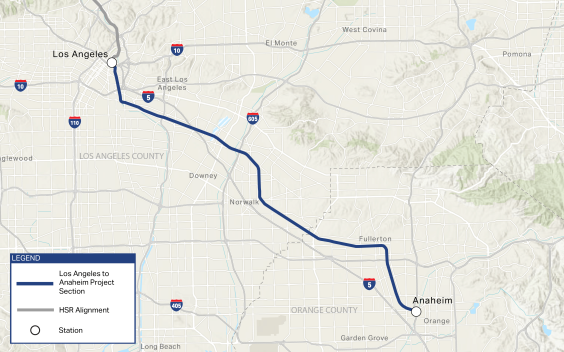 PG&E workers installing an LED streetlight. Photo: PG&E
PG&E workers installing an LED streetlight. Photo: PG&EStreetlights are an enormous part of any city's energy consumption and cities that wish to cut down on their emissions and their energy bills are getting in line to convert their older street lamps to LED technology. According to Clinton Climate Initiative (CCI) and Department of Energy (DOE) data, street lighting costs are one of the biggest components of a city’s utility bill, accounting for 10 percent to 38 percent of the total. With nearly 35 million street lights in the United States, about 1 percent of all electricity is used by street lighting systems.
Like other cities in the Bay Area experimenting with LED streetlights, including San Francisco and Oakland, San Jose has embraced the nascent technology as part of a sustainability platform called Green Vision, which sets ambitious targets for reducing energy
consumption and emissions, including an expected 50 percent or more energy and cost savings from the street lamp conversions.
"Our goal has always been to move to a more energy efficient light," said Laura Stuchinksy, Transportation Sustainability Officer at the San Jose Department of Transportation.
Stuchinsky said San Jose intends to replace all 62,000 streetlights throughout the city before the Green Vision target date of 2022. The city initiated a pilot streetlighting project in Hillview North in 2008 to replace 118 low-pressure sodium streetlights with LEDs and a recent American Recovery and Reinvestment Act (ARRA) stimulus fund grant of $2.2 million will offset implementation costs for the next wave of conversions expected later this year. Further, the city intends to backfill with new renewable energy generated locally and possible purchases through PG&E. San Jose currently spends $4 million annually on street lights, which consumes over 35 million kilowatt hours of electricity, according to Stuchinsky.
In addition to the benefits to the city, the public seems to like the new lights. The Hillview North project, contracted to Echelon Corporation and funded with part of a $200,000 Community Development Block Grant (CDBG) from HUD, had received positive reviews from the community. Even though the new streetlights use less energy, the LEDS give off a broader spectrum of white light than the current yellow hue of the low-pressure sodium lamps, which gives neighbors a greater sense of safety, according to Stuchinsky.
 LED lights side-by-side with sodium lights. Photo: PG&E
LED lights side-by-side with sodium lights. Photo: PG&EAstronomers at Mt. Hamilton's Lick Observatory, 14 miles east of San Jose, are concerned about any increase in city lights, especially LEDS, said Stuchinksy, as they are unable to filter the white light in the same way they do with yellow from sodium lights. In order to convert more lights and remain Dark-Sky compliant, San Jose has been working with manufactures to develop solutions for dimming lights at night or for motion-sensors that would help reduce overall light when it is not needed. While the technology is not yet perfect, Stuchinsky believes that the possibility of contracting with a large municipality like San Jose is leading vendors to be more innovative.
Another obstacle to expansion of LED streetlights is the rate schedule at large utilities such as PG&E, which until recently didn't break LEDs into a separate category so savings could be quantified. Municipalities like San Jose pay monthly block rates, regardless of how much energy is actually used. With PG&E's recent classification change, the utility has set a national example and will make conversion more bankable for other municipalities who have the incentive to move to a lower billing rate.
PG&E spokesperson Joseph Molica said the utility was very excited to assist cities throughout the state with LED conversions. "There are two types of incentives for city customers: a lower rate schedule and they are eligible for energy efficiency rebates," he said.
He hoped Bay Area cities would embrace the new technology as thoroughly as Los Angeles, where the city has committed to replace 140,000 existing
street lamps with LEDs over the next five years, the largest conversion
anywhere in the country. Molica added that ARRA stimulus funds had enabled smaller municipalities like Danville and El Cerrito to initiate trials and that the DOE grants are "coming in almost daily."
Molica said PG&E pilot programs in San Francisco and Oakland over the past two years were
excellent test cases for the utility, which realized energy savings from
different vendors between 50 to 70 percent [for more analysis: Oakland
PDF, San Francisco PDF]. Molica also stressed that the LEDs last many
years longer than current sodium lighting, so savings over the long run
add up significantly. PG&E has also partnered with the CCI to reach
out to more cities across the state to make conversions.
Molica echoed Stuchinsky's assertion that customers approve of the new
lights, saying that PG&E conducted outreach before trials in San
Francisco's Outer Richmond neighborhood and has sought continuous
feedback subsequently. San Francisco Mayor Gavin Newsom earlier this year
touted a new pilot near City Hall that incorporates remote dimming
technology. At the press conference, Newsom turned the lights up
and down with his cell phone (Molica said Newsom used an encrypted code
for accessing the system controls, but it does lead one to wonder if the savvy kids at Black Hat might try hacking the city's lights).
For those who were still skeptical of the new lights, Molica urged patience. "When the public first hears about them, they are not convinced," though over time, he said, they will seem as customary as the yellow sodium lights that were installed decades ago.





